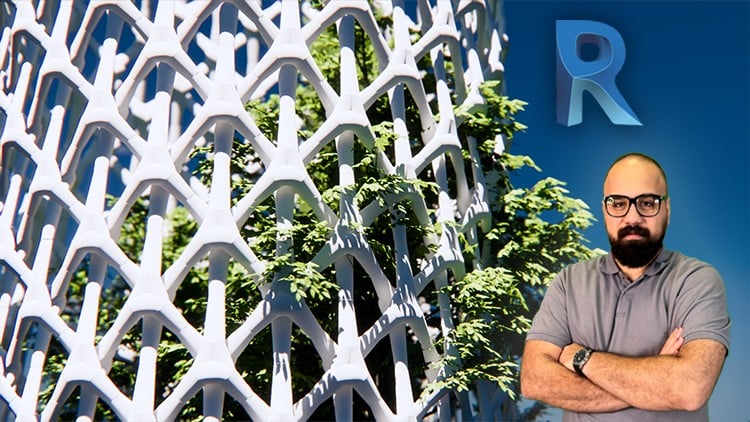
Model movable louver & Voronoi-based panel, advanced dynamic family creation using formula & adaptive Generic component.
⏱️ Length: 6.3 total hours
⭐ 4.69/5 rating
👥 3,954 students
🔄 September 2025 update
Add-On Information:
Note➛ Make sure your 𝐔𝐝𝐞𝐦𝐲 cart has only this course you're going to enroll it now, Remove all other courses from the 𝐔𝐝𝐞𝐦𝐲 cart before Enrolling!
-
Course Overview
- Revolutionary Facade Design: Dive deep into the cutting-edge realm where architectural aesthetics meet computational precision, enabling you to transcend conventional static building envelopes and craft truly responsive, intelligent facades.
- Mastering Parametric Logic: This course serves as your gateway to understanding and implementing sophisticated parametric thinking within Revit, transforming your approach from mere object modeling to creating dynamic systems that react to design inputs.
- Unleashing Design Freedom: Explore the symbiotic relationship between advanced computational design principles and practical BIM execution, allowing for unparalleled freedom in generating complex, visually stunning, and functionally superior architectural forms.
- Beyond Basic Modeling: Elevate your proficiency from fundamental Revit operations to architecting intricate component families that possess inherent intelligence, enabling them to adapt, transform, and interact within a larger design system.
- Integrated Design Workflow: Understand how to seamlessly blend conceptual design exploration with detailed documentation, ensuring that your most ambitious and organic forms are not only achievable but also fully integrated into a robust BIM process.
-
Requirements / Prerequisites
- Fundamental Revit Familiarity: A working knowledge of the basic Revit interface, navigation, and common modeling tools is essential to fully grasp the advanced concepts presented in this course.
- Conceptual Design Aptitude: An interest in exploring complex geometries, computational design, and an eagerness to push the boundaries of traditional architectural forms.
- Mathematical Comfort: While not a prerequisite for advanced mathematics, a basic comfort with logical thinking and an openness to applying simple mathematical relationships in a design context will be beneficial.
- Revit Software Access: Participants should have access to a functional version of Autodesk Revit to follow along with the practical exercises and develop their own projects.
-
Skills Covered / Tools Used
- Algorithmic Design Thinking: Develop a systematic approach to design by formulating architectural problems as logical sequences, allowing for the generation of complex geometries through rule-sets and formulas.
- Advanced Family Authoring: Gain expertise in creating highly adaptable and intelligent Revit families that are not static objects, but rather dynamic components capable of responding to environmental parameters or design intent changes.
- Form-Finding and Optimization: Learn methodologies for exploring various design iterations for facades and louvers, understanding how to control and refine complex forms to achieve specific aesthetic and performance goals.
- Biomimicry in Architecture: Apply principles observed in natural patterns, such as Voronoi diagrams, to generate innovative and structurally efficient architectural skins that mimic organic growth and tessellation.
- Kinetic Architecture Principles: Delve into the design and modeling techniques required to conceptualize and represent elements of kinetic architecture, where parts of the building facade move and transform in response to external stimuli or user input.
- Computational Geometry Applications: Utilize Revit’s inherent capabilities to create, manipulate, and analyze complex geometric patterns, transcending simple extruded or revolved forms into sophisticated, data-driven structures.
- Inter-environment Workflows: Master the strategic application of various Revit environments, including the Conceptual Massing environment for initial form generation and the Adaptive Component editor for detailed panelization, understanding their distinct roles in a comprehensive design process.
-
Benefits / Outcomes
- Elevated Design Portfolio: Significantly enhance your professional portfolio with advanced, visually striking, and technically sophisticated projects that showcase your mastery of parametric and responsive design.
- Competitive Edge in BIM: Position yourself as a highly skilled BIM professional capable of tackling complex architectural challenges, making you an invaluable asset in a rapidly evolving industry that demands innovation.
- Translating Vision to Reality: Acquire the technical prowess to translate highly conceptual and intricate design visions into practical, constructible, and fully documented Revit models, bridging the gap between artistic intent and technical execution.
- Problem-Solving Dexterity: Cultivate a systematic and analytical approach to design problems, empowering you to devise creative solutions for complex facade systems and material optimization.
- Future-Proofing Your Skills: Gain an understanding of the fundamental principles behind algorithmic and adaptive design, preparing you for future advancements in computational architecture and automated design processes.
- Contribution to Sustainable Design: Learn to design facades that are not only aesthetically pleasing but also have the potential for enhanced environmental performance through dynamic shading, controlled ventilation, and optimized material usage.
-
PROS
- Highly Specialized Content: Focuses on a niche yet critical area of architectural design, providing deep expertise.
- Practical Application: Emphasizes hands-on project creation for immediate skill implementation.
- Industry Relevant: Addresses the growing demand for advanced parametric design skills in architecture and construction.
- Expert Instructor: Assumed high quality instruction given the course rating and student numbers.
-
CONS
- Steep Learning Curve for Novices: May be challenging for users with very limited prior Revit experience due to the advanced nature of the topics.
Learning Tracks: English,Design,Architectural Design
Found It Free? Share It Fast!